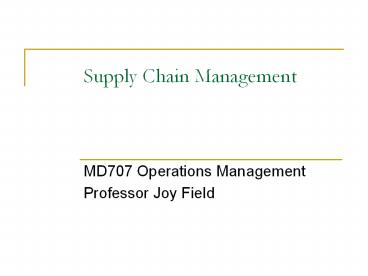Supply Chain Management - PowerPoint PPT Presentation
1 / 8
Title:
Supply Chain Management
Description:
Supply Chain Management MD707 Operations Management Professor Joy Field Definitions Supply Chain The interconnected set of linkages between suppliers of materials and ... – PowerPoint PPT presentation
Number of Views:46
Avg rating:3.0/5.0
Title: Supply Chain Management
1
Supply Chain Management
- MD707 Operations Management
- Professor Joy Field
2
Definitions
- Supply Chain
- The interconnected set of linkages between
suppliers of materials and services that spans
the transformation of raw materials into products
and services and delivers them to a firms
customers - Supply Chain Management
- Synchronizing a firms functions and those of its
suppliers to match the flow of materials,
services, and information with customer demand
3
Developing the Supply ChainInsourcing vs.
Outsourcing Considerations
4
Developing the Supply ChainSupplier Relations
- Competitive Orientation
- The view that negotiations between buyer and
seller is a zero-sum game. Often used when a
firm represents a significant share of the
suppliers sales or many substitutes are
available. Example WalMart - Cooperative Orientation
- The view that the buyer and seller are partners.
Includes sole sourcing. Often used with
strategically important and/or high value-added
components. Example McDonalds - Mixed strategy
- Seeks to combine the advantages of the
competitive orientation (e.g. low prices) with
the cooperative orientation (e.g. few suppliers).
Example Toyota
5
Managing Supply Chain Relationships
6
Strategic Management of the Supply Chain
- Efficient Supply Chains
- The purpose of efficient supply chains is to
coordinate the flow of materials and services so
as to minimize inventories and maximize the
efficiency of the manufacturers and service
providers in the chain. Efficient supply chains
work best when demand is predictable and
products/services are stable. Example of
competitive priorities low cost. - Responsive Supply Chains
- The purpose of responsive supply chains is to
react quickly to market demands by positioning
inventories and capacities in order to hedge
against uncertainties in demand. Responsive
supply chains work best when demand is
unpredictable, new product introduction is
frequent, and product variety is high. Examples
of competitive priorities development speed,
fast delivery, customization, volume flexibility. - In addition
- Innovations in information technology and other
practices are facilitating the integration of the
supply chain for greater efficiency and
responsiveness and enabling orchestrated
networks.
7
Global Outsourcing and Offshoring
- Specific considerations
- Capabilities/resources
- Coordination requirements
- Strategic control and risks
8
Supply Chain DynamicsBullwhip Effect
The bullwhip effect is characterized by
fluctuations in inventory and order levels that
tend to increase as one moves back up the channel
from the final customer. Some causes include lack
of visibility/communication throughout the supply
chain, delays in information flows, ordering and
shipping lags.
- The bullwhip effect can be alleviated by
- Reducing the number of stages in the supply chain
- Communicating consumer demand directly up the
supply chain - Reducing ordering and shipping delays
- Reducing demand destabilizing practices
- Counter consumer gaming during shortages































